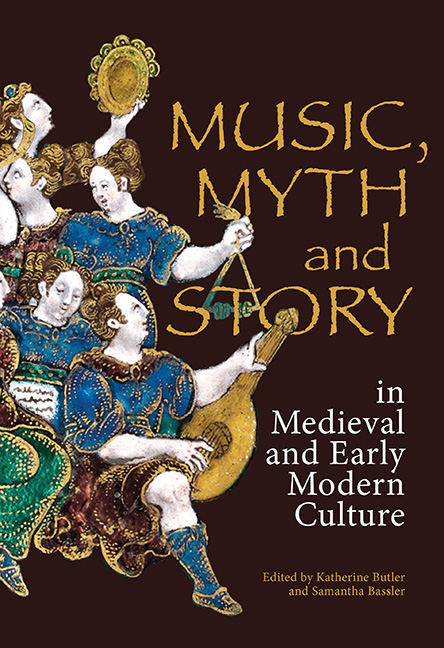Book contents
- Frontmatter
- Contents
- List of Illustrations
- List of Contributors
- Editors’ Note
- Introduction
- I MYTH IN MEDIEVAL MUSIC THEORY AND PHILOSOPHY
- II ICONOLOGIES OF MUSIC AND MYTH
- III MYTHS IN RENAISSANCE PHILOSOPHIES OF MUSIC
- IV MYTH AND MUSICAL PRACTICE
- V NARRATIVES OF PERFORMANCE
- VI MYTH AND MUSIC AS FORMS OF KNOWLEDGE
- VII RE-IMAGINING MYTHS AND STORIES FOR THE STAGE
- 14 ‘Armida's Picture we from Tasso Drew’?: The Rinaldo and Armida Story in Late Seventeenth- and Early Eighteenth-Century English Operatic Entertainments
- 15 Translating Myth Through Tunes: Ebenezer Forrest's Ballad Opera Adaptation of Louis Fuzelier's Momus Fabuliste (1719–29)
- Bibliography
- Index
- Studies in Medieval and Renaissance Music
14 - ‘Armida's Picture we from Tasso Drew’?: The Rinaldo and Armida Story in Late Seventeenth- and Early Eighteenth-Century English Operatic Entertainments
from VII - RE-IMAGINING MYTHS AND STORIES FOR THE STAGE
Published online by Cambridge University Press: 24 October 2019
- Frontmatter
- Contents
- List of Illustrations
- List of Contributors
- Editors’ Note
- Introduction
- I MYTH IN MEDIEVAL MUSIC THEORY AND PHILOSOPHY
- II ICONOLOGIES OF MUSIC AND MYTH
- III MYTHS IN RENAISSANCE PHILOSOPHIES OF MUSIC
- IV MYTH AND MUSICAL PRACTICE
- V NARRATIVES OF PERFORMANCE
- VI MYTH AND MUSIC AS FORMS OF KNOWLEDGE
- VII RE-IMAGINING MYTHS AND STORIES FOR THE STAGE
- 14 ‘Armida's Picture we from Tasso Drew’?: The Rinaldo and Armida Story in Late Seventeenth- and Early Eighteenth-Century English Operatic Entertainments
- 15 Translating Myth Through Tunes: Ebenezer Forrest's Ballad Opera Adaptation of Louis Fuzelier's Momus Fabuliste (1719–29)
- Bibliography
- Index
- Studies in Medieval and Renaissance Music
Summary
ANTHONY Van Dyck's painting, Rinaldo and Armida (c.1629), was commissioned by Endimion Porter for Charles I and was widely disseminated as an engraving throughout Europe (see Plate X). Thus, this evocative image reveals a great deal about the ways the painter and his contemporaries understood Torquato Tasso's epic poem of the Crusades, Gerusalemme liberata (1581). Van Dyck illustrated a famous moment: Rinaldo, the erstwhile warrior, has completely given himself over to pleasure. He slumbers, coaxed into sleep by a Siren's seductive song, as his lover Armida binds him with a garland of flowers – a clear symbol of the dangers of the sensual excess in the sorceress's luxurious bower. Van Dyck emphasised the eroticism of the scene as cupids cavort around the lovers, transforming martial pursuits into humorously phallic ones as they use Rinaldo's tool of war, his sword, as a hobbyhorse. Rinaldo's rescuers, Carlo and Ubaldo, are voyeurs peeking out from the bushes – for the time being, war can wait. Armida, however, is also not immune to the dangers of love. Above her a cupid is about to infect her with love's dart. In short, Van Dyck highlighted the powerful, yet problematic, sensuality of Rinaldo and Armida's relationship, while sidelining the military conflict between Christians and Muslims, the central narrative of the original poem.
We might expect to find this amorous Rinaldo and Armida in the musical versions of the story performed on the late seventeenth- and early eighteenth-century English stage: John Dennis and John Eccles's Rinaldo and Armida (1698) and Aaron Hill, Giacomo Rossi and George Frederic Handel's Rinaldo (1711). Yet strangely, both these works display anxiety about this passionate relationship, re-shaping the characters created by Tasso and so evocatively portrayed in Van Dyck's painting. This squeamishness – the desire to moderate the lovers’ passion or to frame their emotions as problematic – reflected and participated in turn-of-the-century debates about morality, theatre and musical aesthetics. Contemporary political discourses, including those with regards to gender and English national identity, also influenced these re-tellings of Tasso's epic.
JOHN DENNIS'S RINALDO AND ARMIDA (1698): COLLIER, VICE AND THE PERFORMANCE OF EROTICISM
Moral and ethical concerns shaped the way John Dennis (1657–1734), a well-known critic and playwright, approached Tasso's famous story.
- Type
- Chapter
- Information
- Music, Myth and Story in Medieval and Early Modern Culture , pp. 241 - 258Publisher: Boydell & BrewerPrint publication year: 2019



